NCERT Exemplars: Neural Control & Coordination - 2 | NCERT Exemplar & Revision Notes for NEET PDF Download
SHORT ANSWER TYPE QUESTIONS
Q.1. The major parts of the human neural system is depicted below. Fill in the empty boxes with appropriate words.
Ans. 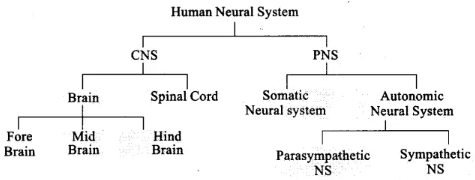
Q.2. What is the difference between electrical transmission and chemical transmission?
Ans.
| Electrical transmission | Chemical transmission | ||
| 1. | Mediated by electrical synapses. | 1. | Mediated through neuro transmitters. |
| 2. | The membranes of pre- and post-synaptic neurons are in very close proximity. | 2. | The membranes of pre- and post- synaptic neurons are separated by synaptic cleft. |
| 3. | Electrical current can flow directly from one neuron into the other across the synapses. | 3. | Neurotransmitters are involved in the transmission of impulses at the synapses. |
| 4. | This transmission is faster. | 4. | This transmission is slower. |
| 5. | These are rare in our system. | 5. | These are common in our system. |
Q.3. Neural system and computers share certain common features. Comment in five lines. (Hint: CPU, input-output devices).
Ans. Neural system and computers share certain common features. The neural system has brain as command and control centre similar to the computer that has CPU (Central processing unit). Sensory organs are input devices of neural system like the mouse and keyboard of the computer. Responses of the body are the output of the neural system.like the data analysis and typed material of the computer. Nerves are comparable to the wires of the computers.
Q.4. If someone receives a blow on the back of neck, what would be the effect on the person’s CNS?
Ans. If someone receives a blow on the back of neck, it may result in the dislocation of the cervical vertebrae that may lead to the injury of the spinal cord passes through neural canal. Injury of spinal cord may lead to paralysis.
Q.5. What is the function ascribed to Eustachian tube?
Ans. A Eustachian tube connects the middle ear cavity with the pharynx. The Eustachian tube helps in equalising the pressures on either sides of the ear drum.
Q.6. Label the following parts in the given diagram using arrow.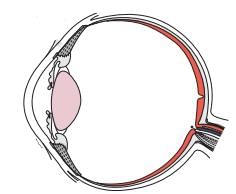
(a) Aqueous chamber
(b) Cornea
(c) Lens
(d) Retina
(e) Vitreous chamber
(f) Blind spot
Ans. 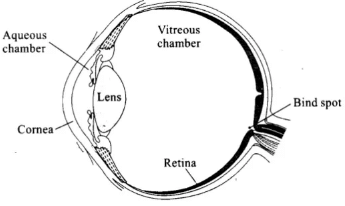
LONG ANSWER TYPE QUESTIONS
Q.1. Explain the process of the transport and release of a neurotransmitter with the help of a labelled diagram showing a complete neuron, axon terminal and synapse.
Ans. A nerve impulse is transmitted from one neuron to another through junctions called synapses. A synapse is formed by the membranes of a presynaptic neuron and a postsynaptic neuron, which may or may not be separated by a gap called synaptic cleft. At a chemical synapse, the membranes of the pre- and post-synaptic neurons are separated by a fluid-filled space called synaptic cleft. Chemicals called neurotransmitters are involved in the transmission of impulses at these synapses. The axon terminals contain vesicles filled with these neurotransmitters. When an impulse (action potential) arrives at the axon terminal, it stimulates the movement of the synaptic vesicles towards the membrane where they fuse with the plasma membrane and release their neurotransmitters in the synaptic cleft. The released neurotransmitters bind to their specific receptors, present on the postsynaptic membrane. This binding opens ion channels allowing the entry of ions which can generate a new potential in the postsynaptic neuron. The new potential developed may be either excitatory or inhibitory.
Q.2. Name the parts of human forebrain indicating their respective functions.
Ans. Forebrain:
The forebrain consists of cerebrum, thalamus and hypothalamus. Cerebrum forms_ the major part of the human brain. A deep cleft divides the cerebrum longitudinally into two halves, which are termed as the left and right cerebral hemispheres. The hemispheres are connected by a tract of nerve fibres called corpus callosum. The layer of cells which covers the cerebral hemisphere is called cerebral cortex and is thrown into prominent folds. The cerebral cortex is referred to as the grey matter due to its greyish appearance. The neuron cell bodies are concentrated here giving the colour. The cerebral cortex contains motor areas, sensory areas and large regions that are neither clearly sensory nor motor in function. These regions called as the association areas are responsible for complex functions like intersensory associations, memory and communication. Fibres of the tracts are covered with the myelin sheath, which constitute the inner part of cerebral hemisphere. They give an opaque white appearance to the layer and, hence, is called the white matter. The cerebrum wraps around a structure called thalamus, which is a major coordinating centre for sensory and motor signaling. Another very important part of the brain called hypothalamus lies at the base of the thalamus. The hypothalamus contains a number of centres which control body temperature, urge for eating and drinking. It also contains several groups of neurosecretory cells, which secrete hormones called hypothalamic hormones. The inner parts of cerebral hemispheres and a group of associated deep structures like amygdala, hippocampus, etc., form a complex structure called the limbic lobe or limbic system. Along with the hypothalamus, it is involved in the regulation of sexual behaviour, expression of emotional reactions (e.g., excitement, pleasure, rage and fear), and motivation.
Q.3. Explain the structure of middle and internal ear with the help of diagram.
Ans. The middle ear contains three ossicles called malleus, incus and stapes which are attached to one another in a chainlike fashion. The malleus is attached to the tympanic membrane and the stapes is attached to the oval window of the cochlea. The ear ossicles increase the efficiency of transmission of sound waves to the inner ear. A Eustachian tube connects the middle ear cavity with the pharynx. The Eustachian tube helps in equalising the pressures on either sides of the ear drum.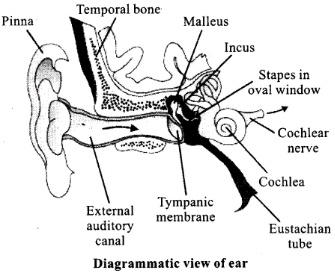
(i) The fluid-filled inner ear called labyrinth consists of two parts, the bony and the membranous labyrinths. The bony labyrinth is a series of channels. Inside these channels lies the membranous labyrinth, which is surrounded by a fluid called perilymph. The membranous labyrinth is filled with a fluid called endolymph. The coiled portion of the labyrinth is called cochlea. The membranes constituting cochlea, the Reissner’s and basilar, divide the surrounding perilymph filled bony labyrinth into an upper scala vestibuli and a lower scala tympani. The space within cochlea called scala media is filled with endolymph. At the base of the cochlea, the scala vestibuli ends at the oval window, while the scala tympani terminates at the round window which opens to the middle ear. The organ of Corti is a structure located on the basilar membrane which contains hair cells that act as auditory receptors. The hair cells are present in rows on the internal side of the organ of Corti. The basal end of the hair cell is in close contact with the afferent nerve fibres. A large number of processes called stereo cilia are projected from the apical part of each hair cell. Above the rows of the hair cells is a thin elastic membrane called tectorial membrane.
(ii) The inner ear also contains a complex system called vestibular apparatus, located above the cochlea. The vestibular apparatus is composed of three semi-circular canals and the otolith (macula is the sensory part of saccule and utricle). Each semi-circular canal lies in a different plane at right angles to each other. The membranous canals are suspended in the perilymph of the bony canals. The base of canals is swollen and is called ampulla, which contains a projecting ridge called crista ampullaris which has hair cells. The saccule and utricle contain a projecting ridge called macula. The crista and macula are the specific receptors of the vestibular apparatus responsible for maintenance of balance of the body and posture.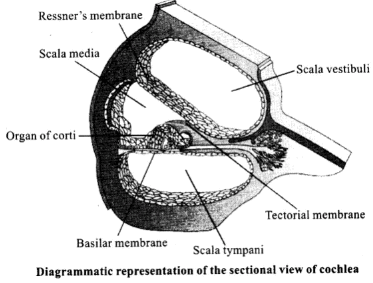
FAQs on NCERT Exemplars: Neural Control & Coordination - 2 - NCERT Exemplar & Revision Notes for NEET
| 1. What is neural control and coordination? |  |
| 2. How does the nervous system function in coordinating body movements? |  |
| 3. What are the major components of the nervous system? |  |
| 4. How are hormones and the nervous system related to each other in coordinating bodily functions? |  |
| 5. What are the common disorders related to neural control and coordination? |  |





















